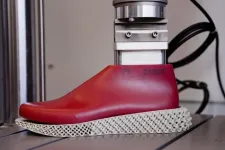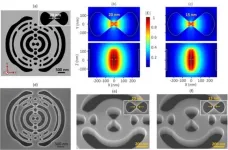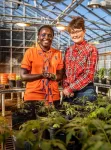(Press-News.org) Ann Arbor, January 24, 2024 – New research confirms what public health leaders have been fearing: the significant uptick in the cardiovascular disease (CVD) death rate that began in 2020 has continued. The continuing trend reverses improvements achieved in the decade before the COVID-19 pandemic to reduce mortalities from heart disease and stroke, the leading causes of death in the United States. The findings are reported in the American Journal of Preventive Medicine, published by Elsevier.
Investigators from the US Centers for Disease Control and Prevention (CDC) and Northwestern University Feinberg School of Medicine analyzed information from more than 10 million death certificates of US adults (aged 35+ years) whose deaths occurred between 2010 and 2022.
Rebecca C. Woodruff, PhD, MPH, Division for Heart Disease and Stroke Prevention, National Center for Chronic Disease Prevention and Health Promotion, Centers for Disease Control and Prevention, Chamblee, GA, explained, “We were concerned about the emerging evidence that chronic disease outcomes worsened during the first two years of the COVID-19 pandemic. This was unfortunately the case with heart disease and stroke, which had been improving before the pandemic. We wanted to understand whether the concerning trends were temporary or whether they continued through 2022.”
Looking at trends each year from 2010 to 2022, the researchers’ findings show that the death rates from cardiovascular disease rose by 9.3% from 2020 through 2022, in contrast to a decline of 8.9% from 2010 to 2019. There were more than 228,000 more CVD deaths from 2020-2022 than would be expected had the pre-2020 trends continued. The reversal was evident across many ages, both sexes, and several race and ethnicity groups.
Dr. Woodruff characterized the results as an enduring setback in population health, evident after the public health emergency had largely stabilized. She pointed to several possible explanations for the increases:
The pandemic disrupted access to healthcare for many people, which may have resulted in delays in detecting and treating chronic or acute heart disease.
The crisis also disrupted many aspects of daily life that may have made it harder for people to do the things that prevent heart disease, including managing blood pressure, eating well, being physically active, quitting tobacco, getting healthy sleep, managing weight, controlling cholesterol, and managing blood sugar.
An emerging body of evidence also suggests that people who have had COVID-19 are at increased risk for new or worsening heart disease, which may have contributed to the subsequent increase in cardiovascular death rates.
Dr. Woodruff noted, “Research to understand the drivers of these increases in CVD mortality rates can help guide clinical and public health approaches to prevent, detect, and treat CVD. Reprioritizing prevention and management of CVD is an essential first step.”
She highlighted several federal initiatives that focus on decreasing the burden of CVD: WISE WOMAN (Well-integrated Screening and Evaluation for Women Across the Nation, Paul Coverdell National Acute Stroke Program, and Million Hearts®, adding that “the magnitude of the setbacks in CVD mortality and the range of affected subgroups speak to the need for broader prevention efforts moving forward.”
END
Post pandemic, US cardiovascular death rate continues upward trajectory
Concerning trend erases a decade of progress in curtailing fatal heart attacks and strokes, according to research reported in the American Journal of Preventive Medicine
2024-01-24
ELSE PRESS RELEASES FROM THIS DATE:
New model predicts how shoe properties affect a runner’s performance
2024-01-24
A good shoe can make a huge difference for runners, from career marathoners to couch-to-5K first-timers. But every runner is unique, and a shoe that works for one might trip up another. Outside of trying on a rack of different designs, there’s no quick and easy way to know which shoe best suits a person’s particular running style.
MIT engineers are hoping to change that with a new model that predicts how certain shoe properties will affect a runner’s performance.
The simple model incorporates ...
Sub-wavelength confinement of light demonstrated in indium phosphide nanocavity
2024-01-24
WASHINGTON — As we transition to a new era in computing, there is a need for new devices that integrate electronic and photonic functionalities at the nanoscale while enhancing the interaction between photons and electrons. In an important step toward fulfilling this need, researchers have developed a new III-V semiconductor nanocavity that confines light at levels below the so-called diffraction limit.
“Nanocavities with ultrasmall mode volumes hold great promise for improving a wide range of photonic ...
Laura M. Barzilai, JD, LLM, elected Chair of Board of Directors of the American Federation for Aging Research (AFAR)
2024-01-24
NEW YORK— The American Federation for Aging Research (AFAR), a national, nonprofit whose mission is to advance and support healthy aging through biomedical research, is pleased to announce the election of Laura M. Barzilai, JD, LLM, as Chair of the Board of Directors.
Stephanie Lederman, EdM, AFAR Executive Director, shares: "The Board of Directors of AFAR unanimously elected Laura Barzilai as Chair in December 2023. For nearly a decade, her contributions as a board member, committee chair, ...
Talking tomatoes: How their communication is influenced by enemies and friends
2024-01-24
Plants produce a range of chemicals known as volatile organic compounds that influence their interactions with the world around them. In a new study, researchers at the University of Illinois Urbana-Champaign investigated how the type and amount of these VOCs change based on different features of tomato plants.
The smell of cut grass is one of the defining fragrances of summer. Smells like that are one of the ways plants signal their injury. Because they cannot run away from danger, plants have evolved to communicate with each other using chemical signals. They use VOCs for a ...
Thomas A. Rando, MD, PhD, elected President of the Board of Directors of the American Federation for Aging Research (AFAR)
2024-01-24
The American Federation for Aging Research (AFAR), a national, nonprofit whose mission is to advance and support healthy aging through biomedical research, is pleased to announce the election of Thomas A. Rando, MD, PhD, as President of the Board of Directors in December 2023.
Dr. Rando is currently the Director of the Eli and Edythe Broad Center of Regenerative Medicine and Stem Cell Biology at UCLA, where he is a professor of Neurology and Molecular, Cell, and Developmental Biology. Previously, he ...
Fast-charging lithium battery seeks to eliminate ‘range anxiety’
2024-01-24
ITHACA, N.Y. – Cornell University engineers have created a new lithium battery that can charge in under five minutes – faster than any such battery on the market – while maintaining stable performance over extended cycles of charging and discharging.
The breakthrough could alleviate “range anxiety” among drivers who worry electric vehicles cannot travel long distances without a time-consuming recharge.
“Range anxiety is a greater barrier to electrification in transportation than any of the other barriers, like cost and capability of batteries, and we have identified a pathway to eliminate it using rational electrode designs,” said Lynden ...
Chemistry professor R. Graham Cooks expands research of water droplet interfaces that offer the secret ingredient for building life
2024-01-24
R. Graham Cooks, the Henry B. Hass Distinguished Professor of Chemistry, and his postdoctoral researcher Lingqi Qiu have experimental evidence that the key step in protein formation can occur in droplets of pure water, and have recently published these findings in the Proceedings of the National Academy of Sciences (PNAS).
In this key step, amino acids are dehydrated (they lose water) even though they are in a water solution, a paradox that is resolved by the fact that these droplet surfaces are unusually dry and highly ...
Brain mechanism teaches mice to avoid bullies
2024-01-24
Like humans, mice live in complex social groups, fight over territory and mates, and learn when it is safer to avoid certain opponents. After losing even a brief fight, the defeated animals will flee from the mice that hurt them for weeks afterward, a new study shows.
Led by researchers at NYU Grossman School of Medicine, the study reveals that such “retreating behavior” is influenced by a distinct area on the underside of the hypothalamus, a part of the brain that controls hunger, sleep, and levels of many hormones. The team had previously found that this special region, called the anterior ventrolateral part of the ventromedial hypothalamus (aVMHvl), ...
New tool reveals gene behavior in bacteria
2024-01-24
Bacterial infections cause millions of deaths each year, with the global threat made worse by the increasing resistance of the microbes to antibiotic treatments. This is due in part to the ability of bacteria to switch genes on and off as they sense environmental changes, including the presence of drugs. Such switching is accomplished through transcription, which converts the DNA in genes into its chemical cousin in mRNA, which guides the building of proteins that make up the microbe’s structure.
For this ...
Chemists use the blockchain to simulate over 4 billion chemical reactions essential to the origins of life
2024-01-24
Cryptocurrency is usually “mined” through the blockchain by asking a computer to perform a complicated mathematical problem in exchange for tokens of cryptocurrency. But in research appearing in the journal Chem on January 24, a team of chemists have repurposed this process, asking computers to instead generate the largest network ever created of chemical reactions which may have given rise to prebiotic molecules on early Earth.
This work indicates that at least some primitive forms of metabolism might have emerged without the involvement of ...
LAST 30 PRESS RELEASES:
University of Oklahoma researcher awarded funding to pursue AI-powered material design
Exploring how the visual system recovers following injury
Support for parents with infants at pediatric check-ups leads to better reading and math skills in elementary school
Kids’ behavioral health is a growing share of family health costs
Day & night: Cancer disrupts the brain’s natural rhythm
COVID-19 vaccination significantly reduces risk to pregnant women and baby
The role of vaccination in maternal and perinatal outcomes associated with COVID-19 in pregnancy
Mayo Clinic smartwatch system helps parents shorten and defuse children's severe tantrums early
Behavioral health spending spikes to 40% of all children’s health expenditures, nearly doubling in a decade
Digital cognitive behavioral treatment for generalized anxiety disorder
Expenditures for pediatric behavioral health care over time and estimated family financial burden
Air conditioning in nursing homes and mortality during extreme heat
The Alps to lose a record number of glaciers in the next decade
What makes a good proton conductor?
New science reporting guide published for journalists in Bulgaria
New international study reveals major survival gaps among children with cancer
New science reporting guide published for journalists in Turkey
Scientists develop a smarter mRNA therapy that knows which cells to target
Neuroanatomy-informed brain–machine hybrid intelligence for robust acoustic target detection
Eight SwRI hydrogen projects funded by ENERGYWERX
The Lundquist Institute and its start-up company Vitalex Biosciences Announces Strategic Advancement of Second-Generation fungal Vaccine VXV-01 through Phase 1 Trials under $40 Million Competitive Con
Fine particles in pollution are associated with early signs of autoimmune disease
Review article | Towards a Global Ground-Based Earth Observatory (GGBEO): Leveraging existing systems and networks
Penn and UMich create world’s smallest programmable, autonomous robots
Cleveland researchers launch first major study to address ‘hidden performance killer’ in athletes
To connect across politics, try saying what you oppose
Modulating key interaction prevents virus from entering cells
Project explores barriers to NHS career progression facing international medical graduates
Jeonbuk National University researchers explore the impact of different seasonings on the flavor perception of Doenjang soup
Two Keck Medicine of USC Hospitals named Leapfrog Top Teaching Hospitals
[Press-News.org] Post pandemic, US cardiovascular death rate continues upward trajectoryConcerning trend erases a decade of progress in curtailing fatal heart attacks and strokes, according to research reported in the American Journal of Preventive Medicine




